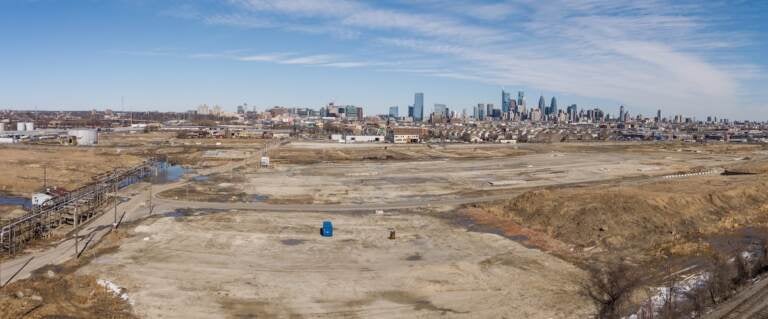Years after shutdown, cancer-causing chemical still detected at former refinery site
Nearly three years after the PES refinery closed, levels of cancer-causing benzene found at its property line are still higher than many operating refineries.

File photo: The North Yard of the former PES refinery, where the site's new owners have largely finished demolition. (Courtesy of Hilco Redevelopment Partners)
The massive explosion that shuttered the PES refinery in South Philadelphia happened nearly three years ago. Today, more than half of the jungle of pipes, tanks, and buildings on the site have been torn down. But monitors on the property’s edge continue to pick up high levels of a cancer-causing chemical, on par with operating refineries across the country.
The site’s new owner, Hilco Redevelopment Partners (HRP), is seeking a permit update that, if approved, would officially remove requirements that the company monitor for the chemical, benzene, at its fenceline. The company has not committed to continuing to monitor voluntarily — something community advocates want.
“There’s a high level of benzene being emitted, whether it’s for 20 minutes or 20 days — you have to take precaution,” said Shawmar Pitts, a strategy organizer with Philly Thrive and lifelong resident of Grays Ferry, a neighborhood near the refinery. “You have to warn people.”
An analysis released last week by the Environmental Integrity Project (EIP), a watchdog nonprofit founded by former EPA staff, suggests the shuttered PES refinery site remains one of the biggest polluters of benzene among refineries nationwide — despite the fact that the Philly site is dormant, and its current owner is preparing to redevelop it into an ecommerce logistics hub.
The report shows that last year, the former PES refinery site had the second highest annual average of peak concentrations of benzene measured along its fenceline per two-week monitoring period, compared to over a hundred other refineries nationwide. The former PES site clocked in at 19 micrograms of benzene per cubic meter (µg/m3) — six times the level EIP uses to indicate a potential long-term health threat.
The former PES site also came in second place for a measure the EPA uses to approximate benzene levels coming from refineries themselves, apart from any background levels in surrounding communities. The measure, known as “net” benzene levels, subtracts the lowest fenceline reading from the highest during a given two-week monitoring period. EIP’s analysis found that last year, the former PES refinery’s average net benzene level was 18.5 µg/m3 — more than twice the EPA’s “action level,” which the agency uses to determine which refineries need to investigate root causes of their excess emissions.
“[Benzene concentrations were] high before the refinery closed,” said EIP spokesperson Tom Pelton. “Then it spiked in the year of the explosion. And it’s still high now.”
Although the report shows benzene levels at the Philly site topping those at dozens of operating refineries, Philly’s numbers are an improvement from both 2019 — the year of the massive refinery explosion — and 2020.
Concerns about health risks
Benzene is a colorless liquid found in crude oil and gasoline. It evaporates quickly and has a sweet odor. Long-term exposure is known to cause cancer, specifically leukemia. Exposure to high levels can cause drowsiness, dizziness, and headaches.
To Ezra Wood, chemistry professor at Drexel University, the levels of benzene picked up at the fenceline of the former PES refinery site last year are “concerning.”
“I would expect the levels to have dropped much more ever since the explosion in June 2019,” Wood said.
Last year’s levels put nearby neighbors at greater risk of cancer and other health issues, Wood said. But it’s hard to say how great the risks are, without knowing how much of the benzene travels away from the fenceline and to where people actually live.
“If there is a big source right at the refinery, then measuring the fenceline, that’s useful, but it doesn’t tell you everything,” Wood said. “That’s not what people are breathing, actually.”
Representatives of Hilco Redevelopment Partners (HRP), the site’s new owners, have pushed back against the idea that the site is emitting high levels of the cancer-causing chemical.
Julianna Connolly, HRP’s executive vice president for environmental remediation, characterizes EIP’s analysis as misleading. In an interview Friday, she said the nonprofit’s measures do not reflect average levels of benzene at the site’s fenceline overall, which are generally lower. Spikes are temporary, she said.
“We don’t see sustained concentrations that are elevated,” she said. “We see occasional peaks at different spots.”
The average concentration of benzene at the perimeter of the property last year was less than 3 µg/m3, Connolly said.
But at least one fenceline monitor peaked above the EPA action level most months — including several times at a monitor on the southern portion of the site, along the western bank of the Schuylkill River. During a two-week period starting in late August 2021, that monitor picked up the highest benzene concentration of the year: 130 μg/m³ — more than four times a level EIP says poses short-term health risks.
Where are the emissions coming from?
It’s not clear where exactly the benzene emissions are coming from.
Asked whether the EPA has a theory for what could be causing high levels of benzene to continue to be detected on the edge of the former PES refinery site, spokesperson Roy Seneca said in an emailed statement that the agency “continues to review data on emissions in the area.”
“Be aware that the fenceline monitor(s) at the former PES facility are also located near other potential emission sources, including roadways,” he wrote.
Connolly, of HRP, also said that external or mobile sources — like idling trucks — could be causing the high readings.
“The benzene data do not indicate sustained elevated concentrations at the perimeter of the property during decommissioning and demolition activities, which began in mid-2020,” she said.
But others, like Peter DeCarlo, environmental health and engineering professor at Johns Hopkins University, suggested emissions could be coming from storage tanks on the property. Pelton, of EIP, said they could be emanating from the contaminated soil or getting stirred up during the demolition process. Wood, of Drexel, declined to speculate.
“I do find these to be surprisingly high,” he said.
Will the site’s owners keep monitoring?
The old operating permit governing the refinery site — dating back to before it closed down — required benzene monitoring along the fenceline, in accordance with the 2015 Refinery Sector Rule. But because the refinery is no longer operating, HRP argues the site is no longer subject to the rule (Seneca, of the EPA, said the agency “continues to review permitting and regulatory applicability.”).
“It’s a little gray,” Connolly said. “So we are choosing right now to continue to do this sampling until the … permit is modified.”
HRP has an application pending before Phialdelphia’s Air Management Services for a permit update that would reflect the fact that the refinery has shut down — removing polluting equipment from the permit, and reclassifying the facility’s industry as demolition, rather than petroleum refining.
The reclassification would officially drop the benzene monitoring requirements. Matt Rankin, a spokesperson for Air Management Services, says the agency does not expect to issue a decision for several months.
Asked whether the company would continue to monitor for benzene voluntarily, Connolly declined to commit.
“We just need to see what the permit modification requirements would be,” she said. “Then we’ll see what we’re obligated to do under the permit and then what makes sense to do voluntarily.”
Joe Ingrao, legal fellow at the Clean Air Council, an environmental health advocacy organization, said if the reclassification is approved, neighbors could stop getting the “granular data” that led to EIP’s report. Ingrao’s organization commented on HRP’s permit application, arguing the company should continue to be required to monitor benzene levels at its fenceline. In fact, Ingrao says HRP should be required to monitor now.
“They still have related emissions, and they’re still considered a major source of hazardous air pollutants,” he said. “So it’s the Council’s position that they still should have to … do the fenceline monitoring.”
Pitts, the activist with Philly Thrive, said if AMS approves the reclassification without requiring monitoring, he would bet “every penny” that HRP will stop monitoring.
“That’s the kind of nonsense that lets you know where they stand,” he said.

Subscribe to PlanPhilly
WHYY is your source for fact-based, in-depth journalism and information. As a nonprofit organization, we rely on financial support from readers like you. Please give today.









